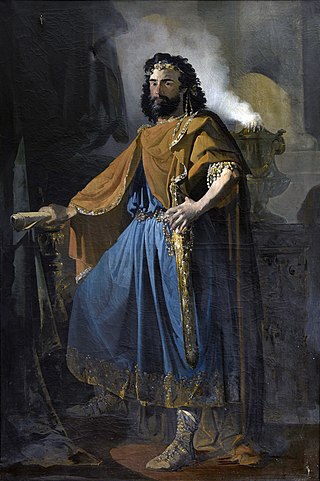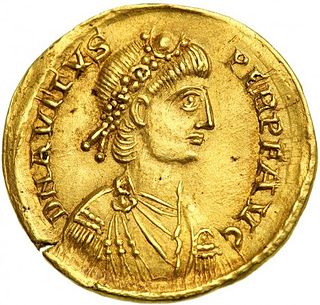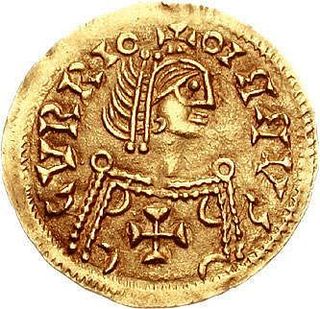Sources
- Jaques, Tony (2007). Dictionary of Battles and Sieges: A-E. Greenwood Publishing Group. ISBN 978-0313335372.
| Siege of Arles | |||||||
|---|---|---|---|---|---|---|---|
| Part of Gothic revolt of Theodoric I | |||||||
| |||||||
| Belligerents | |||||||
| Visigoths | Western Roman Empire Huns | ||||||
| Commanders and leaders | |||||||
| Theodoric I | Flavius Aetius | ||||||
| Strength | |||||||
| Unknown | Unknown | ||||||
| Casualties and losses | |||||||
| Unknown | Unknown | ||||||
The Battle of Arles was fought between the Visigoths and a Roman-Hunnic alliance in 425. The Visigoths and the Romans had previously been in peace, but in 425 the Visigothic king Theodoric I broke the peace treaty and invaded Gaul, laying siege to Arles. He was defeated and driven away by the Romans, under the leadership of Flavius Aetius, and their Hunnic allies. Theodoric thereafter made peace again, instead turning his sights on the Vandals in Hispania.

Alaric II was the King of the Visigoths from 484 until 507. He succeeded his father Euric as king of the Visigoths in Toulouse on 28 December 484; he was the great-grandson of the more famous Alaric I, who sacked Rome in 410. He established his capital at Aire-sur-l'Adour in Aquitaine. His dominions included not only the majority of Hispania but also Gallia Aquitania and the greater part of an as-yet undivided Gallia Narbonensis.
The 5th century is the time period from AD 401 through AD 500 (D) in accordance with the Julian calendar. The 5th century is noted for being a period of migration and political instability throughout Eurasia.
The 450s decade ran from January 1, 450, to December 31, 459.

Euric, also known as Evaric, son of Theodoric I, ruled as king (rex) of the Visigoths, after murdering his brother, Theodoric II, from 466 until his death in 484. Sometimes he is called Euric II.

Eparchius Avitus was Roman emperor of the Western Empire from July 455 to October 456. He was a senator of Gallic extraction and a high-ranking officer both in the civil and military administration, as well as Bishop of Piacenza.

The Battle of the Catalaunian Plains, also called the Battle of the Campus Mauriacus, Battle of Châlons, Battle of Troyes or the Battle of Maurica, took place on June 20, 451 AD, between a coalition, led by the Roman general Flavius Aetius and the Visigothic king Theodoric I, against the Huns and their vassals, commanded by their king, Attila. It proved one of the last major military operations of the Western Roman Empire, although Germanic foederati composed the majority of the coalition army. Whether the battle was of strategic significance is disputed; historians generally agree that the siege of Aurelianum was the decisive moment in the campaign and stopped the Huns' attempt to advance any further into Roman territory or establish vassals in Roman Gaul. However, the Huns successfully looted and pillaged much of Gaul and crippled the military capacity of the Romans and Visigoths. Attila died only two years later, in 453; after the Battle of Nedao in 454 AD, the coalition of the Huns and the incorporated Germanic vassals gradually disintegrated.

This is a chronology of warfare between the Romans and various Germanic peoples. The nature of these wars varied through time between Roman conquest, Germanic uprisings, later Germanic invasions of the Western Roman Empire that started in the late second century BC, and more. The series of conflicts was one factor which led to the ultimate downfall of the Western Roman Empire in particular and ancient Rome in general in 476.
The Gothic wars or Roman–Gothic wars were a long series of conflicts between the Goths and the Roman Empire between the years 249 and 554 AD. The main wars are detailed below.

The Visigothic Kingdom, Visigothic Spain or Kingdom of the Goths occupied what is now southwestern France and the Iberian Peninsula from the 5th to the 8th centuries. One of the Germanic successor states to the Western Roman Empire, it was originally created by the settlement of the Visigoths under King Wallia in the province of Gallia Aquitania in southwest Gaul by the Roman government and then extended by conquest over all of Hispania. The Kingdom maintained independence from the Eastern Roman or Byzantine Empire, whose attempts to re-establish Roman authority in Hispania were only partially successful and short-lived.

Theodoric I was the King of the Visigoths from 418 to 451. Theodoric is famous for his part in stopping Attila the Hun at the Battle of the Catalaunian Plains in 451, where he was killed.
The Battle of Arelate was fought in 458 near Arelate (Arles) between Western Roman Emperor Majorian and Visigothic king Theodoric II. After the assassination of Flavius Aetius in 454, the Visigoths began to expand their kingdom at the expense of the crumbling Roman administration in Gaul and Hispania. When Majorian became emperor in 457, the Visigoths under king Theodoric II had just recently defeated the Suebic Kingdom in north-west Hispania and were consolidating their hold on the rest of the peninsula.
The Battle of Arles was fought between the Visigoths and the Western Roman Empire in 435. The Visigoths and the Romans had previously been in peace after having fought each other at Arles in 425, but in 435 the Visigothic king Theodoric I again broke the peace treaty and invaded Gaul, laying siege to Arles once more. He was however defeated and driven away by the Romans under the leadership of Flavius Aetius and his largely Hunnic army. Two years later, Theodoric was defeated at a decisive battle at Narbonne.
The Battle of Toulouse was fought between the Visigoths and the Western Roman Empire in 439. Having previously defeated the Visigoths at Narbonne, the Roman general Litorius led his largely Hunnic army against Toulouse, the capital of the Visigothic Kingdom. During the siege, the Visigothic king Theodoric I attacked the Roman camp and inflicted heavy casualties. Litorius was captured and executed. Since the Visigoths also suffered heavy losses, Theodoric made peace with the Roman governor Avitus.
The Battle of Toulouse was fought in the Gothic War between the Visigoths and the Western Roman Empire in 458. The battle was part of a great mid-winter expedition made across the alps by Emperor Majorian, taking a large army from Italy into Gaul with the goal of restoring the region to Roman rule after the disastrous reign of Avitus. Majorian and the Visigothic king Theodoric II fought a battle at Toulouse, in which the Visigoths were defeated. Majorian thereafter secured the cooperation of the Visigoths against the Suebi in Spain. However, fighting resumed, and Theodoric was finally defeated at Orléans in 463.
The Battle of Arles was fought between the Visigoths and the Western Roman Empire in 471. Prior to the battle, the Visigoths had advanced past the Bretons at the Battle of Déols in 469, and were expanding into Aquitaine. Alarmed with this development, Emperor Anthemius sent an expedition under Anthemiolus across the Alps against the Visigothic king Euric, who was besieging Arles. Euric crushed the Roman army and killed Anthemiolus and three Roman counts. Euric subsequently captured Arles and much of southern Gaul. The defeat in Gaul was a direct cause of the subsequent overthrow of Anthemius as emperor by Ricimer.
Battle of Arles may refer to:

Gothic revolt of Theodoric I was an uprising of the Gothic Fouderati in Aquitaine during the regime of Emperor Valentinian III (425-455). That rebellion was led by Theodoric I, King of the Visigoths and took place in the South of France. The uprising took place between 425 and 426, in the period shortly after the death of usurpator John and was terminated by a military operation under the command of Aëtius.

The Gothic War (436–439) was a military conflict between the Gothic foederati and the Western Roman Empire under Emperor Valentinian III. It occurred primarily in the Gallic provinces from 436 to 439. The key figures involved were the Gothic leader Theodoric I and the Roman army's commander-in-chief, Aetius. Contemporary sources characterize this conflict as a war. Additionally, there were uprisings of the Burgundians and the Bagaudae during the same period.

The Gothic War of 457-458 was a military conflict between the Visigoths of Theoderic II against the Western Roman Empire of Emperor Majorian. The war began in 457 with a revolt of the Goths in Aquitania that pushed aside Roman authority, followed by an aggressive conquest in the adjacent Septimania aimed at area expansion. The war ended with a Roman victory over the Goths in the Battle of Arles in 458.